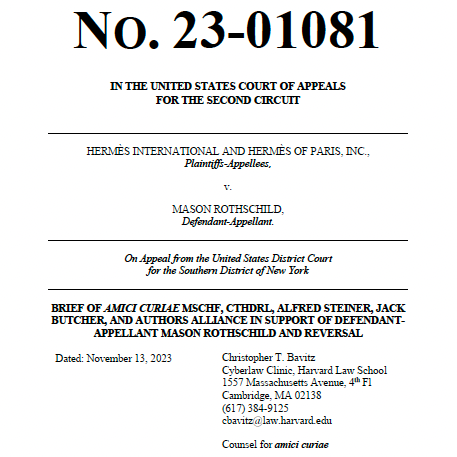
Last month, the Cyberlaw Clinic filed an amicus brief in Hermès International v. Rothschild in the United States Court of Appeals for the Second Circuit, on behalf of individual artists, creators, and arts and cultural organizations that represent the interests of creators. The brief supports an appeal by digital artist Mason Rothschild, who was sued by French luxury good brand Hermès for allegedly infringing Hermès’s trademark when he created non-fungible tokens (NFTs) that depict a range of reimagined Birkin bags titled “MetaBirkins.” Rothschild asserted his freedom to comment on society, consumerism, and luxury goods, arguing that the NFTs are a tribute to the bag and a commentary on both animal cruelty and consumerism within the fashion industry. A jury in the United States District Court for the Southern District of New York decided in favor of Hermès, and Rothschild appealed.
The amicus brief—joined by a coalition that includes MSCHF, CTHDRL, Alfred Steiner, Jack Butcher, and Authors Alliance—emphasizes the vital importance of the Second Circuit’s three-decade old decision in Rogers v. Grimaldi, 875 F.2d 994 (2d Cir. 1989). In Rogers, the Court endeavored to protect creativity and balance the interests of trademark owners and the interests of those who engage with trademarks and trademarked goods or services through art. The Rogers test—which established First Amendment exit ramps for trademark infringement analysis—is critical to ensuring the existence of a thriving artistic society (including the sort of cultural commentary and critique that are vital to public discourse). The brief argues that Rogers remains good law after the United States Supreme Court’s recent decision in Jack Daniel’s Props. v. VIP Prods. LLC, 599 U.S. 140 (2023) and that an artist’s intent to sell or otherwise commercialize their art—including art that engages with or references trademarks—is not relevant when balancing trademark owners’ and artists’ rights.
Amici represent the creative interests at stake in the appeal. These artists, creators, and organizations are concerned that a ruling in favor of Hermès will stifle artists’ ability to comment on popular brands and companies. They have a strong interest in ensuring that the law reflects the balance between creators’ First Amendment rights and the rights of trademark owners to protect their marks and brands.
The amici that joined the brief are:
- MSCHF, an art collective that engages art, fashion, tech, and capitalism. The collective subverts mass/popular culture and corporate operations as tools for critique and intervention.
- CTHDRL, a digital design and experience studio located in New York and Los Angeles that uses technology to shape culture. They cultivate ideas at the edge of technology to build the next generation of internet-native consumer brands.
- Alfred Steiner, an artist living and working in New York who often creates works that pose novel aesthetic and legal questions.
- Jack Butcher, an artist who leads internet-native art practice, Visualize Value—a platform that publishes art exploring the intersection of technology, and culture. Visualize Value exists to challenge convention and provide a unique perspective on the contemporary world.
- Authors Alliance, a non-profit organization with over 2,300 members. Its mission is to advance the interests of authors who want to serve the public good by sharing their creations broadly.
Fall 2023 Cyberlaw Clinic students Naomi Meron, Phoenix Shaw, and Trina Sultan worked on the brief, collaborating closely with the amici and with the Clinic’s Managing Director, Chris Bavitz. The Clinic looks forward to Second Circuit’s decision in this case.
